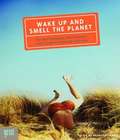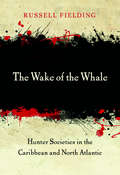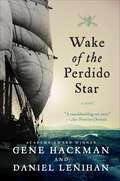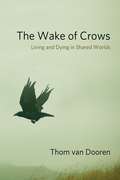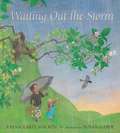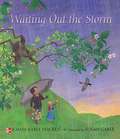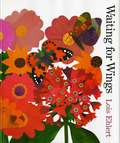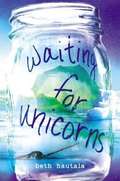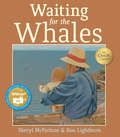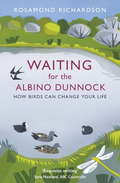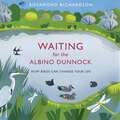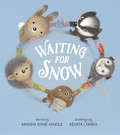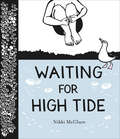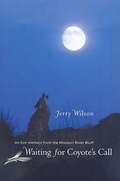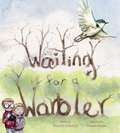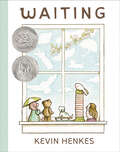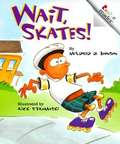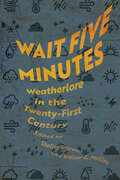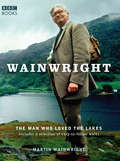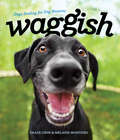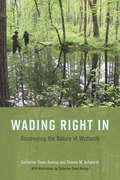- Table View
- List View
Wake Up And Smell The Planet: The Non-Pompous, Non-Preachy Grist Guide To Greening Your Day
by Brangien Davis Katharine WrothBased on the Grist website (www. grist. org), this compact guide to making environmentally-responsible choices on a daily basis is an irreverent complement to Al Gore's PowerPoint approach. Davis (a writer/editor in Seattle) and Wroth (an environmental writer) discuss sustainable alternatives to everything from autos to dog, diaper, and electronic waste.
The Wake of the Whale: Hunter Societies in the Caribbean and North Atlantic
by Russell FieldingDespite declining stocks and health risks, island communities in the Caribbean and North Atlantic still use traditional methods to hunt whales and dolphins for food. Russell Fielding presents the art, history, and purpose of whaling in these different cultures and describes what their future might look like as modern realities take hold.
Wake of the Perdido Star: A Novel
by Gene Hackman Daniel LenihanThe Oscar-winning actor teams up with a shipwreck diving expert to spin a cinematic tale of nineteenth century pirates, shipwrecks, and sea adventure.In 1805, seventeen-year-old Jack O’Reilly sets sail with his parents from America to Cuba aboard the Perdido Star. But when tragedy strikes shortly after their arrival, Jack makes a desperate escape, rejoining the departing Star as a member of the crew. On his yearslong journey around the globe, he only grows more obsessed with avenging the murder of his parents.By the time he returns to Cuba, Jack has faced storms, shipwreck, and deadly battles. He leads a renegade band who call themselves the Right Honourable Brotherhood of the Shipwrecked Men of the Star. But having seen and suffered so much, what is Jack now willing to sacrifice for revenge?Hackman and Lenihan infuse this swashbuckling tale with authentic details of 19th century seafaring and deep sea diving. The hero Jack is joined by a colorful cast of characters, including Paul Le Maire, the aristocratic intellectual who earns Jack’s friendship; Quince, the first mate, Jack’s mentor and defender; Quen-Li, the mysterious Chinese cook whose skills extend beyond the galley; Hansumbob, the ship’s poet, whose simplicity belies a wisdom born of the heart; and the greedy Count de Silva, whose charm masks a murderous soul.
The Wake of Crows: Living and Dying in Shared Worlds (Critical Perspectives on Animals: Theory, Culture, Science, and Law)
by Thom van DoorenCrows can be found almost everywhere that people are, from tropical islands to deserts and arctic forests, from densely populated cities to suburbs and farms. Across these diverse landscapes, many species of crow are doing well: their intelligent and adaptive ways of life have allowed them to thrive amid human-driven transformations. Indeed, crows are frequently disliked for their success, seen as pests, threats, and scavengers on the detritus of human life. But among the vast variety of crows, there are also critically endangered species that are barely hanging on to existence, some of them the subjects of passionate conservation efforts.The Wake of Crows is an exploration of the entangled lives of humans and crows. Focusing on five key sites, Thom van Dooren asks how we might live well with crows in a changing world. He explores contemporary possibilities for shared life emerging in the context of ongoing processes of globalization, colonization, urbanization, and climate change. Moving among these diverse contexts, this book tells stories of extermination and extinction alongside fragile efforts to better understand and make room for other species. Grounded in the careful work of paying attention to particular crows and their people, The Wake of Crows is an effort to imagine and put into practice a multispecies ethics. In so doing, van Dooren explores some of the possibilities that still exist for living and dying well on this damaged planet.
Waiting Out the Storm
by JoAnn Early MackenWind whistles in the treetops, thunder rumbles, and lightning flashes and dashes between raindrops. Snug inside, a mother and child listen, watch, and wonder what the animals will do during the storm. Paired with beautiful illustrations evoking the moods and mysteries of the natural world, this lyrical call-and-response text is a lullaby to stormy weather — and to the warmth and safety of home.
Waiting Out the Storm (Elementary Core Reading)
by JoAnn Early Macken Susan GaberNIMAC-sourced textbook
Waiting For Wings
by Lois EhlertEvery spring, butterflies emerge and dazzle the world with their vibrant beauty. But where do butterflies come from? How are they born? What do they eat--and how? With a simple, rhyming text and glorious color-drenched collage, Lois Ehlert provides clear answers to these and other questions as she follows the life cycle of four common butterflies, from their beginnings as tiny hidden eggs and hungry caterpillars to their transformation into full-grown butterflies. Complete with butterfly and flower facts and identification tips, as well as a guide to planting a butterfly garden, this butterfly book is like no other.
Waiting for Unicorns
by Beth HautalaA novel about one girl's journey to the arctic, where she discovers the power of letting go of pain and opening up to second chancesWhen twelve-year-old Talia--still reeling from the recent death of her mother--is forced to travel with her emotionally and physically distant whale-researcher father to the Arctic for the summer, she begins to wonder if the broken pieces inside of her will ever begin to heal. Like her jar of wishes, Talia feels bottled up and torn. Everything about life in Churchill feels foreign, including Sura, the traditional Inuit woman whom Talia must live with. But when Sura exposes her to the tradition of storytelling, she unlocks something within Talia that has long since been buried: her ability to hope, to believe again in making wishes come true.A rich and poignant story about opening up--to new people, to second chances, to moving forward with life. Praise for Waiting for Unicorns:"Debut author Hautala's writing in this first-person narrative is lyrical and evocative; her descriptions of the landscape are vivid. Written by an author to watch, this quiet story of loss and healing will appeal to thoughtful readers." --Kirkus Reviews"This poignant story demonstrates that opening up to new experiences, places, and people can enrich life even in the aftermath of tragedy."--School Library Journal"[An] affecting exploration of grief and the hope that can come through the love of good friends. With spellbinding descriptions...this story will stay with readers."--Publishers Weekly"Contemplative writing...a thoughtful examination of loss and hope."--Booklist
Waiting for the Whales
by Ron Lightburn Sheryl McfarlaneIn this timeless story set on the West Coast, an old man lives alone on a bluff overlooking the sea and tends his garden. And waits. Only when the whales return each year to the bay in front of his cottage is his loneliness eased. One day, his daughter and her baby return home to live with the old man, bringing a renewed sense of purpose to his life. As his granddaughter grows, the old man passes on a wealth or knowledge and wisdom as well as his passion for the whales. And each year they wait together for the whales to appear. A gentle story that illuminates the unique friendship between grandparent and child, Waiting for the Whales also suggests that aging and death are only part of a greater cycle of rebirth and continuity.
Waiting for the Whales
by Sheryl McFarlaneIn this timeless classic set on the West Coast, an old man lives alone on a bluff overlooking the sea, tends his garden and waits. Only when the whales return each year to the bay in front of his cottage is his loneliness eased. One day his daughter and her baby return home to live with the old man, bringing a renewed sense of purpose to his life. As his granddaughter grows, the old man passes on a wealth of knowledge and wisdom as well as his passion for the whales. And each year they wait together for the whales to appear. Waiting for the Whales illuminates the unique friendship between grandparent and child and celebrates the restorative power of the natural world. Originally published twenty-five years ago, this award-winning picture book is sure to enchant a whole new generation of readers.
Waiting for the Albino Dunnock: How birds can change your life
by Rosamond Richardson'A beautiful book' Tim Birkhead, author of Bird Sense'The prose is sublime, and so is the intelligence behind it' Bel Mooney, Daily MailThe extraordinary world of birds has the power to change lives, as it did the author's. The pleasure and fascination of bird-watching, together with the silence and stillness involved, can play a part in changing the way that we live our lives - and can help us when we have to deal with adversity.Personal and elegiac, Waiting for the Albino Dunnock shows us how beauty is central to our emotional wellbeing, and reminds us of the careless damage we are inflicting on the natural world. This glorious pilgrimage into the soaring world of birds opens our eyes afresh to the beauty which surrounds us.
Waiting for the Albino Dunnock: How birds can change your life
by Rosamond Richardson'A beautiful book' Tim Birkhead, author of BIRD SENSE'A glorious, beautifully written pilgrimage into the soaring world of birds' Bel Mooney, DAILY MAILWritten by a beginner-birdwatcher with the freshness and passion of a convert, WAITING FOR THE ALBINO DUNNOCK explores the world of birds through the seasons of a single year. It describes encounters with particular birds in the landscapes of East Anglia where the author is rooted. Occasional journeys farther afield take the reader to truly wild places in the Outer Hebrides and Eastern Europe. Yet the ordinary experience of birdwatching is also far more than just that. The beauty of birds has the power to change lives, as it did the author's, and as in the case of the all-but-legendary snow leopard, it is more about the search than the result.Personal and elegiac in tone, the writing is an unusual combination of prose poems based on the actual experience of seeing a specific bird for the first time, woven with elements of science and wisdom traditions, ornithology (and its punning counterpart ornitheology), mythology and philosophy, taxonomy and history, literature and folklore, conveying the wider picture of what it means to be human in relationship to nature. WAITING FOR THE ALBINO DUNNOCK explores the degree to which wildness is embedded in the human psyche and how beauty is central to our mental and emotional wellbeing, while highlighting the careless damage we are inflicting on the natural world.
Waiting for the Albino Dunnock: How birds can change your life
by Rosamond RichardsonWritten by a beginner-birdwatcher with the freshness and passion of a convert, WAITING FOR THE ALBINO DUNNOCK explores the world of birds through the seasons of a single year. It describes encounters with particular birds in the landscapes of East Anglia where the author is rooted. Occasional journeys farther afield take the reader to truly wild places in the Outer Hebrides and Eastern Europe. Yet the ordinary experience of birdwatching is also far more than just that. The beauty of birds has the power to change lives, as it did the author's, and as in the case of the all-but-legendary snow leopard, it is more about the search than the result.Personal and elegiac in tone, the writing is an unusual combination of prose poems based on the actual experience of seeing a specific bird for the first time, woven with elements of science and wisdom traditions, ornithology (and its punning counterpart ornitheology), mythology and philosophy, taxonomy and history, literature and folklore, conveying the wider picture of what it means to be human in relationship to nature. WAITING FOR THE ALBINO DUNNOCK explores the degree to which wildness is embedded in the human psyche and how beauty is central to our mental and emotional wellbeing, while highlighting the careless damage we are inflicting on the natural world.Read by Jane Whittenshaw(p) 2017 Orion Publishing Group
Waiting for Snow
by Marsha Diane Arnold Renata LiwskaBadger cannot wait one more minute for it to snow. When his friend Hedgehog explains that everything comes in its time, Badger is as unconvinced and impatient as ever. But Badger’s friends have a few tricks up their sleeve to try to get the snow’s attention and distract their pal in the meantime. In the end, Badger sees there’s no trick—only waiting—until at last, it’s time.
Waiting for Rain: Drought in Ethiopia
by Lisa MoranIn 2000 the African nation of Ethiopia faced a terrible drought. Ten million people were in danger of starving. How did aid groups rescue millions of people from the brink of disaster?
Waiting for High Tide
by Nikki McClureFor one young boy, it’s a perfect summer day to spend at the beach with his family. He scours the high tide line for treasures, listens to the swizzling sound of barnacles, and practices walking the plank. But mostly he waits for high tide. Then he’ll be able to swim and dive off the log raft his family is building. While he waits, sea birds and other creatures mirror the family’s behaviors: building and hunting, wading and eating. At long last the tide arrives, and human and animal alike savor the water. Another beautiful ode to life lived in harmony with nature, and by the labor of one’s own hands, from an artist of great warmth and clarity.
Waiting for Coyote's Call: An Eco-memoir from the Missouri River Bluff
by Jerry WilsonInspired by the works of Henry David Thoreau, Aldo Leopold, and Annie Dillard, Jerry Wilson's eco-memoir Waiting for Coyote's Call covers twenty-five years of trying to live life while leaving as small an environmental footprint as possible. Wilson encourages the reader to think about his or her place in nature as he recounts his own family's experiences on prairie and woodland near the Missouri River in eastern South Dakota. Wilson chronicles his family's building of an eco-friendly solar home and their attempts to restore the plowed-under prairie to its original state. He muses on the beauty and simplicity of nature in contrast to modern lifestyles in which time is ever-more precious and convenience often outweighs other considerations. Taking the reader on midnight rambles through his "Big Woods," Wilson shares his wonder at the creatures that also make their home on the bluff. From his delight in home-grown tomatoes and high-flying Sandhill cranes to concerns about human interaction with the web of life, the stories of Wilson's quarter of a century on the Missouri River bluff spring off the pages of Waiting for Coyote's Call. Fawns leap and turkeys strut past his window as Wilson listens for the plaintive howl of the prairie predator.
Waiting for a Warbler
by Sneed B. Collard IIIShort listed for the Green Earth book award In early April, as Owen and his sister search the hickories, oaks, and dogwoods for returning birds, a huge group of birds leaves the misty mountain slopes of the Yucatan peninsula for the 600-mile flight across the Gulf of Mexico to their summer nesting grounds. One of them is a Cerulean warbler. He will lose more than half his body weight even if the journey goes well. Aloft over the vast ocean, the birds encourage each other with squeaky chirps that say, “We are still alive. We can do this.” Owen’s family watches televised reports of a great storm over the Gulf of Mexico, fearing what it may mean for migrating songbirds. In alternating spreads, we wait and hope with Owen, then struggle through the storm with the warbler. This moving story with its hopeful ending appeals to us to preserve the things we love. The backmatter includes a North American bird migration map, birding information for kids, and guidance for how native plantings can transform yards into bird and wildlife habitat.
Waiting
by Kevin HenkesWhat are you waiting for? An owl, a puppy, a bear, a rabbit, and a pig wait for marvelous things to happen in this irresistible and resonant picture book by the New York Times–bestselling and Caldecott Medalist Kevin Henkes.Five friends sit happily on a windowsill, waiting for something amazing to happen. The owl is waiting for the moon. The pig is waiting for the rain. The bear is waiting for the wind. The puppy is waiting for the snow. And the rabbit is just looking out the window because he likes to wait! What will happen? Will patience win in the end? Or someday will the friends stop waiting and do something unexpected?Waiting is a big part of childhood—waiting in line, waiting to grow up, waiting for something special to happen—but in this book, a child sets the stage and pulls the strings. Timeless, beautiful, and deeply heartfelt, this picture book about imaginative play, the seasons, friendship, and surprises is a Caldecott Honor and Geisel Honor Book.Share Waiting alongside Mo Willems's Waiting Is Not Easy at home or in a classroom—these books about waiting for kids will be enjoyed as picture book stories and also allow kids to explore their emotions about that ultimate frustration: waiting.“The short sentences of the text flow with the precision one would expect from a master picture-book creator like Henkes. Little ones, to whom each experience is new, will know what it’s like to dream and wait.”—ALA Booklist
Wait, Skates! (Fountas & Pinnell LLI Blue #Level E)
by Mildred Johnson Rick StromoskiA child putting on in-line roller skates for the first time must make them wait until they are ready to go straight.
Wait Five Minutes: Weatherlore in the Twenty-First Century
by Shelley Ingram, Willow G. MullinsContributions by Emma Frances Bloomfield, Sheila Bock, Kristen Bradley, Hannah Chapple, James Deutsch, Máirt Hanley, Christine Hoffmann, Kate Parker Horigan, Shelley Ingram, John Laudun, Jordan Lovejoy, Lena Marander-Eklund, Jennifer Morrison, Willow G. Mullins, Anne Pryor, Todd Richardson, and Claire Schmidt The weather governs our lives. It fills gaps in conversations, determines our dress, and influences our architecture. No matter how much our lives may have moved indoors, no matter how much we may rely on technology, we still monitor the weather. Wait Five Minutes: Weatherlore in the Twenty-First Century draws from folkloric, literary, and scientific theory to offer up new ways of thinking about this most ancient of phenomena.Weatherlore is a concept that describes the folk beliefs and traditions about the weather that are passed down casually among groups of people. Weatherlore can be predictive, such as the belief that more black than brown fuzz on a woolly bear caterpillar signals a harsh winter. It can be the familiar commentary that eases daily social interactions, such as asking, “Is it hot (or cold) enough for you?” Other times, it is simply ubiquitous: “If you don’t like the weather, wait five minutes and it will change.” From detailing personal experiences at picnics and suburban lawns to critically analyzing storm stories, novels, and flood legends, contributors offer engaging multidisciplinary perspectives on weatherlore. As we move further into the twenty-first century, an increasing awareness of climate change and its impacts on daily life calls for a folkloristic reckoning with the weather and a rising need to examine vernacular understandings of weather and climate. Weatherlore helps us understand and shape global political conversations about climate change and biopolitics at the same time that it influences individual, group, and regional lives and identities. We use weather, and thus its folklore, to make meaning of ourselves, our groups, and, quite literally, our world.
Wainwright: The Man Who Loved the Lakes
by Martin WainwrightWainwright: The Man Who Loved the Lakes is a celebration of the British landscape, and it tells the remarkable story of Alfred Wainwright who in 1952 decided to hand draw a series of guides to the fells of Lakeland. For the next 13 years he spent every weekend walking, and every weekday evening drawing and writing - completing one page per night. The result was Wainwright's Pictorial Guides to the Lakeland Fells. Although initially self published they have now sold over a million copies and are still popular and much loved today. He went on to present a series of TV shows on the BBC about walking in the Lake District that made him even better known. He was an unlikely celebrity, he preferred his own company and thought walking in the countryside should be a solitary rather than group pursuit. Wainwright: The Man Who Loved the Lakes introduces him to a new generation of lovers of the countryside, features some of Wainwright's favourite walks and is lavishly illustrated, including stunning aerial shots of the Lake District.
Waggish: Dogs Smiling For Dog Reasons
by Grace Chon Melanie MonteiroTo be "waggish" is to be playful and mischievous—the very definition of these adorable dogs and the things they (might) think about us There's no mistaking a happy dog. The wagging tail, the eager eyes, the smile that's impossible to fake. A happy dog radiates pure joy. Yet the mystery remains: What's really going on behind those waggish grins? Are our dogs laughing with us? At us? Are they operating at a higher stage of enlightenment . . . or just buttering us up before we discover the tiny, torn remnants of burrito wrapper suspiciously dotting the hallway? In Waggish, the infinite expressions of happy dogs are captured in an amazing series of photographs by renowned animal photographer Grace Chon, whose images have made her the go-to pet photographer of Hollywood’s top celebrities. As for what these dogs are really thinking, writer Melanie Monteiro expertly channels their innermost thoughts, pairing each photo with a caption such as, “If loving tennis balls is wrong, I don’t want to be right” and “You know, we’ll both get outside a lot quicker if you just forget the pants.” Waggish is the perfect gift for every dog lover.
Wading Right In: Discovering the Nature of Wetlands
by Catherine Owen Koning Sharon M. AshworthWhere can you find mosses that change landscapes, salamanders with algae in their skin, and carnivorous plants containing whole ecosystems in their furled leaves? Where can you find swamp-trompers, wildlife watchers, marsh managers, and mud-mad scientists? In wetlands, those complex habitats that play such vital ecological roles. In Wading Right In, Catherine Owen Koning and Sharon M. Ashworth take us on a journey into wetlands through stories from the people who wade in the muck. Traveling alongside scientists, explorers, and kids with waders and nets, the authors uncover the inextricably entwined relationships between the water flows, natural chemistry, soils, flora, and fauna of our floodplain forests, fens, bogs, marshes, and mires. Tales of mighty efforts to protect rare orchids, restore salt marshes, and preserve sedge meadows become portals through which we visit major wetland types and discover their secrets, while also learning critical ecological lessons. The United States still loses wetlands at a rate of 13,800 acres per year. Such loss diminishes the water quality of our rivers and lakes, depletes our capacity for flood control, reduces our ability to mitigate climate change, and further impoverishes our biodiversity. Koning and Ashworth’s stories captivate the imagination and inspire the emotional and intellectual connections we need to commit to protecting these magical and mysterious places.
